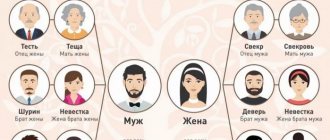In recent decades, it has even become popular not only to be interested in one’s roots and ancestors, but also to find out and clarify who is someone’s godfather, matchmaker, brother-in-law, and so on. It turns out that a family can be much larger, given all the intricacies of the destinies of its members.
People became especially interested in the question of the depth of family ties. For example, cousins, second cousins and brothers. What next? Are there fourth cousins or what to call them? Or who is your cousin's daughter?
Terminology
Determining family ties has always been a rather difficult matter, since families in our country have traditionally been large. And even now, when all the relatives gather for one big festive table or are just planning to do so, it is not always clear who is who’s matchmaker or brother. But nevertheless, blood or half-bred, but this is relatives.
It should be taken as an axiom that the first married couple known by name, from which the line of the family descends, is called the ancestors.
Other terms require more specific explanation:
- Blood relatives.
- Not blood relatives - brothers-in-law.
In blood family ties, there is an order of kinship, determined by the proximity of lateral branches in the family tree. That is, you can be blood, but distant relatives - brothers, sisters, aunts, grandmothers, etc.
Brother-in-law - what is a relative?
So, brother-in-law is none other than the wife's brother. What word did this name come from?
“Brother-in-law squints his eyes.” Probably, this proverb says that a loving brother of his wife closely watches whether his young husband offends his sister.
The word brother-in-law most likely has a common root with the word “to sew.” That is, this is a relative who is “attached” to a young family through the marriage of a sister.
It is interesting that in English there is a word sure, which should be translated into Russian as faithful, reliable.
A brother-in-law is someone who is related to your family. In most cases, he supports young people and helps them. This relative can become the godfather of the couple's child, which will further strengthen family ties.
The sister's husband - the brother-in-law must understand this - needs his help in establishing relationships with his wife and her parents. These two men can get along well, especially if they have a small age difference. Common interests will make them true friends, and the family will be stronger, friendlier, stronger.
The strengthening of such a connection is, of course, influenced by the intrafamily mentality. In order for brother and husband to become closer and dearer to each other, the sister must remember that there are holidays that they can celebrate together. If she communicates more with her brother’s wife, organizes common feasts, invites her for walks with the children, then the men will definitely communicate better with each other. By the way, the brother-in-law’s wife is the young family’s daughter-in-law. If the brother does not have a wife, then his sister can take care of introducing him to a pretty unmarried friend who can become his soul mate.
Blood relatives and not so much
Blood relatives include all those who are related by the actual fact of birth from one of the family members.
And those who came from other families are not blood or stepfamilies. These are also called brothers-in-law. Blood relatives include:
- native;
- cousins;
- second cousins;
- brother/sister;
- Uncle Aunt;
- nephews;
- grandmother grandfather;
- grandchildren, etc.
And these are brothers-in-law, that is, not blood relatives:
- son-in-law is the husband of a daughter or sister;
- sister-in-law, sister-in-law, sister-in-law - husband’s sister;
- daughter-in-law - son's wife (for his father);
- godfathers - godfather and mother in relation to the godson's parents and each other;
- matchmaker, matchmaker or matchmakers - father and mother of the wife or husband in relation to the parents of the second spouse;
- daughter-in-law - wife of a son or brother;
- stepson or stepdaughter - a step-son or daughter in relation to one of the spouses;
- stepfather - the husband of the children's mother, but not their natural father;
- stepmother is the father’s new wife, but not the natural mother of his children;
- mother-in-law and father-in-law are the husband's parents;
- father-in-law and mother-in-law are the wife’s parents;
- primak - a son-in-law who came to live in the house of his wife or her parents;
- brother-in-law - wife's only brother;
- brother-in-law is the husband’s only-begotten or half-brother.
A little history
There has long been a tradition in Rus': if men, having passed the tests, became strong friends, then they exchanged crosses. It was a kind of oath of faithful friendship. People became brothers. Such an oath was not broken. The named brother took on the obligations characteristic of blood relatives. He became the protector of his friend's wife and the patron of his children.
It must be said that the attitude towards the traditions of twinning was very serious. Such cases have been described in the literature. So, Ilya Muromets fraternized with Dobrynya after a notorious fight. The initially hostile relationship was replaced by complete spiritual kinship, which is very significant. The fact that the traditions of fraternization have been preserved, although the world has changed a lot, is considered a very good sign. This indicates the relevance and relevance of traditional values. The Russian world, which is being talked about a lot now, is proposed to be built precisely on these ancient traditions that we inherited from our great ancestors.
Family ties
How close (or not so close) people are is determined by the distance of the relationship. There are relatives of the first order, second and so on. This kinship is viewed along the vertical line of the family tree. That is:
The first priority is parents, children, sisters and brothers (half- and half-brothers), and grandchildren.
The second is grandparents, nephews and nieces.
Third in order of kinship are aunts, uncles, cousins and brothers.
Fourth - kinship through great-grandparents - all second cousins.
Fifth stage - Relatives through great-uncles and grandmothers, including cousins.
The sixth stage is great-aunts, uncles, great-great-grandchildren and nephews (for example, a cousin’s daughter).
This division allows us to determine who belongs to whom and by whom. Thus, asking the question in this context in the circle of a large family, who is the daughter of a cousin, one can determine according to this scheme. This is the most distant line among blood relatives.
Kinship groups
It must be said that we have lost the habit of considering anyone other than those who are relatives by blood. Some cynical people do not even consider husband and wife as family! Oddly enough, you can also become related through the marriage of someone from your family. Such relatives are called in-laws, they are sister-in-law and brother-in-law. These are those who have become their own, to be literal.
You can also find relatives through the baptism of children. Such connections are called nepotistic.
Sisters and brothers
Who are sisters and brothers? These are daughters or sons of the same parents, if they are relatives. If they are cousins, then a cousin (brother) is a daughter (son) of a brother or sister of a father or mother.
Now let’s try to understand who my cousin’s daughter is, who she is to me. That is, this is a child from the daughter of my uncle or aunt. This is already considered kinship from the second generation (generation). And a second cousin is already the third generation down.
According to one of the Russian terminologies, such a sister is called a “sister”. There is also a tendency to call all first cousins, second cousins, etc., brothers and sisters cousins (cousin or cousin).
If this is the daughter of mom or dad's cousin, then she is not their cousin. In this version, she is a first cousin for the parents, and a second cousin for their children.
If this is the daughter of a grandmother or grandfather’s cousin, then the latter is a second cousin, although a distant blood relative for mom and dad. The first is their fourth cousin.
So who is my cousin's daughter? Is there a difference from proximity and blood relationship in this case? There is necessarily a blood relationship in this option, but regardless of whether the daughter of a brother or sister on the father’s or mother’s side is called a niece. And if this is the daughter of a cousin or brother, then the niece is, accordingly, a cousin.
Famous cousins with wedding rings
But the word “sister” comes from the ancient Indian – stri or “woman”, literally “one’s own woman”. The word itself became known in the 11th century, and only in medieval Europe did definitions of first cousins, second cousins and other relatives appear.
Being sisters and brothers on paper does not mean understanding each other in the soul. So who is this cousin? For example, Charles Darwin, Rachmaninov, Edvard Grieg, Edgar Poe and even Bach married along this line of kinship. They married their cousins, absolutely without any mental trauma with prohibitions. The cousins were chosen as husbands by Catherine the Great, Queen Isabella. Previously, especially in titled circles, mixing of blood was commonplace, so no one treated such marriages from the point of view of a taboo. A cousin could be a husband at the same time, and a cousin could be a wife.
Today, weddings between brothers and sisters are rejected by the church and the law. Mixing blood leads to numerous health problems for offspring. Children and grandchildren may be born with defects and deviations. If earlier in royal circles the wedding of cousins was commonplace, since it was important for the government of states, now this is rejected by society.
Necessity
Unfortunately, we do not always remember family ties in order to strengthen or increase the family circle of loved ones. The presence of a rich relative in one of the branches of the family tree gives a fairly strong impetus to determine the closeness of kinship in the event of an inheritance. And here, as they say, the Civil Code can help if there is no will.
In any case, drawing up a family tree and searching for distant branches of relatives is not only fashionable, exciting, but also useful. After all, every family necessarily has at least one mysteriously lyrical relationship story, which can serve as a plot for a fashionable novel.
Narrowing the circle of relatives
More recently, close people lived in large families, trying to live, if not under the same roof, then at least next door. Relatives were united by common interests, they helped each other cope with difficulties, and celebrated holidays together.
Now relatives communicate in a narrower circle. Mainly grandparents, children, grandchildren.
Why don’t we know our second cousins and, with a frown, ask the question: “Who is brother-in-law?”
The fact is that with the development of society, easier living and working conditions, people have become more independent of each other. Previously, for example, in order to wash clothes, you had to find two or three hours of free time; now this issue can be solved by simply pressing a button. People communicated more closely because help was needed; it was difficult to live without the support of relatives and friends.
mother-in-law
Another frequently asked question: “What is the origin of the words “mother-in-law” and “mother-in-law”?” If we have dealt with the first one, now let’s pay attention to the second one.
Mother-in-law is the mother of the wife. There are many jokes and tales about mother-in-law and son-in-law. The kind “mother” does not like her acquired son. He tries to intrigue him, but it doesn’t work out very well.
Meanwhile, this word comes from the Ukrainian language. In Russia it is believed that it comes from the word “crackle”. The mother-in-law chatters incessantly, asking for advice, which greatly irritates her son-in-law.
Another possible origin of the word is “to crack your nails.” Allegedly, the mother-in-law snaps her fingers and cracks her nails. Here is the named son and is angry with “mother”.
Difficult relationships
We found out what versions exist regarding the origin of “mother-in-law” and how this word came into our language. Let's touch on the topic of relations between sons-in-law and mothers-in-law, because we have already talked about daughters-in-law and mothers-in-law.
Why don't mothers-in-law like their son-in-law? Probably for the same reason as mothers-in-law. Jealousy is banal. It seems that they raised and nurtured their daughter, and then some guy appeared and took her away. He treats the girl badly and offends her. And it’s okay that the girl doesn’t work, but takes care of the house. The son-in-law is bad - that's it.









